5 Tips for Managing Canine Separation Anxiety
Managing canine separation anxiety sucks, I’m not gonna lie. My dog Carter had a pretty bad case and it was heart breaking to watch. He’d panic every time I left the house, and that panic continued well after I was gone. I felt absolutely helpless.
I read every book and article I could get my hands on, and although I’d see a slight improvement on occasion his anxiety kept getting worse. Unable to get control of the situation on my own I reached out for help.
Finally with the help of a wonderful trainer I was able to start managing his anxiety. For me the biggest difference was understanding that management had to be done in small parts, and understanding that progress takes time.
Here’s what I learned, and how I ended up managing my dog’s separation anxiety. Here’s 5 tips for managing canine separation anxiety.
The Symptoms of Separation Anxiety in Dogs
Does your dog get anxious and panic when you leave? Do they bark, whine or howl anytime you’re out of sight? Do they try to follow you out the door as you’re leaving? If so they’re exhibiting signs of separation anxiety.
Keep in mind not all problem behaviors are the result of separation anxiety. If you come home to find that your dog has chewed up your shoes it may be due to boredom and not knowing of a better way to keep himself entertained. Issues that are caused by separation anxiety happen when you leave, in your absence and sometimes as you’re getting ready to leave.
Typically dogs with separation anxiety exhibit these troublesome behaviors as you’re leaving, but depending on the severity of your dog’s anxiety those behaviors can continue for hours. The most common symptoms of separation anxiety in dogs include:
- Barking, whining, howling
- Trying to follow you, sneak out the door
- Destructive behaviors such as chewing, digging
- Defecating, urinating in the house
- Excessive drooling
- Excessive panting
- Hyperactivity or aggression as you’re leaving
- Hiding when you leave
- Not eating
It’s not fully understood why some dogs suffer from separation anxiety and others don’t. But remember, your dog’s behaviors are part of a panic response. Your dog isn’t trying to punish you! They just want you to come home! – Humane Society of the United States
Why Separation Anxiety Needs To Be Managed
Separation anxiety in dogs is like any other anxiety issue — it’s a fear based behavior. If you or anyone you know has suffered from anxiety you know how exhausting and serious it can be — especially when left untreated.
Dogs with separation anxiety panic when their owner leaves, and that panic can continue for hours. And that anxiety can have serious implications when it comes to a dog’s overall well being.
Unfortunately our dogs can’t tell us exactly why they’re so anxious, and they’ll continue to panic until the issue is addressed. For most dogs separation anxiety is progressive, and it will continue to get worse over time. If you’re able to intervene early we can stop the behavior before it gets that serious.
Assess The Severity Of Your Dog’s Separation Anxiety
Before diving in for treatment options it’s important to take a step back and assess the severity of your dog’s separation anxiety. Does your dog exhibit signs of extreme panic when you’re gone such as trying to escape or howling for hours? If so your dog has a severe case, and those are tricky to manage.
Because severe cases are so hard to treat I recommend getting help from a professional behaviorist or trainer. Separation anxiety can cause long periods of extreme panic in dogs, and in severe cases like that you likely need professional help to make it manageable.
Does your dog try to sneak through the door as you’re leaving or whine for a few minutes after you leave before setting down? That’s moderate separation anxiety, and makes it more manageable. It doesn’t mean it’s easy, but it is doable. However, if your dog’s anxiety seems to get worse over time please seek out help — these issues get worse over time if not properly addressed.
5 Tips For Managing Canine Separation Anxiety
Bad news first. Separation anxiety is a behavior that won’t just get better on it’s own; without management it will worse.
Dogs that have had separation anxiety for some time will need counter conditioning to get rid of all the negative associations they have with being alone. It’s important to understand that managing separation anxiety will take a lot of time and commitment on your part; it can’t be cured overnight.
At this point you may be wondering why I’m pointing out all of these negatives. Well, when I was looking for help dealing with my own dog’s separation anxiety the articles I read never addressed how difficult managing it can be. So when I didn’t see results overnight I assumed it was because I failed. Turns out treating anxiety isn’t that simple.
So I’m not going to sugarcoat this. These tips will work, but they take a lot of commitment on your part. Step by step, repeating the same things over and over. It will get tedious, but with time you will start to see improvements.
Now let’s move onto the good part. You can help your dog with proper management. My previous dog Carter had a pretty bad case of separation anxiety, and these tips (along with some patience and understanding) helped make it manageable. Here’s 5 steps for managing canine separation anxiety.
1. Keep Your Dog Calm As You Practice Getting Ready
The first step in managing canine separation anxiety is learning how to keep your dog calm while you get ready. And the best way to get started is by practicing that routine, and slowly getting them used to that ritual in a way that won’t rile them up.
Dogs know our routines just as well as we do, and for many the routine of getting ready for work causes our dogs to start getting anxious before we even step out the door. To help manage you dog’s separation anxiety it’s important to keep them calm while doing your getting ready routine. Your getting ready routine includes all of the things you do before going to work such as taking a shower, getting dressed, doing your hair/makeup, putting on your shoes, and grabbing your keys/purse.
Dogs are smart. They know that once you’ve showered and start getting dressed in the morning you’re getting ready to leave. And if your dog has separation anxiety every little thing you do in the morning acts as a trigger, causing them to start getting anxious. To help manage their anxiety your goal will be to turn those parts of your routine into a positive (or at the very least neutral) experience for them. And to do that you’ll need to work on some counter conditioning and desensitization with your dog.
Pick a time when have some extra time to work with your dog. Then start practicing keeping your dog calm while you do one of the activities from your getting ready routine.
Keep in mind each dog is different — and the part of your routine that you’ll want to start with is one that causes the least amount of anxiety in your dog. For example, the act of putting on your shoes may cause a lot of anxiety in your dog because it’s probably one of the very last things you do before you leave. Start with a part of your routine that doesn’t make your dog quite so anxious.
Once you’ve chosen a part of your routine it’s time to work on keeping your dog calm while you practice it. This is what the goal of counter conditioning and desensitization is — changing your dog’s emotional response to something. Now it’s easier said than done, but with repetition and proper management you can change the way your dog reacts to situations or stimuli.
How to Keep Your Dog Calm As You Get Ready
For this example let’s say you’ve chosen to work on keeping your dog calm while you brush your teeth — an activity that causes a little bit of anxiety in your dog, but not to the point of being unmanageable.
The easiest way to turn the act of brushing your teeth into a more positive experience for your dog (rather than an anxiety inducing one) is to use food. As your dog is watching you get ready to brush your teeth toss a treat their way, and then toss another as you grab the toothpaste. Gauge your dog’s response — if they still seem somewhat nervous you may need to take a step back and just work on the act of picking up your toothbrush.
It may seem weird to reward your dog for something as simple as watching you brush your teeth, but it’s part of the process. Giving your dog something positive to focus on while you’re doing something that would normally cause them anxiety will slowly start to change your dog’s attitude towards it.
Rather than thinking “oh no she’s brushing her teeth, that mean’s she’s getting ready to go” your dog will start to think of brushing your teeth as the time when they get that yummy treat. It shifts their focus away from the negative associations they’ve built up over time and gives them something more positive to focus on.
Each dog is different, and the severity of your dog’s separation anxiety will determine what pace you can work at when it comes to desensitizing them to the things that make them nervous.
If they do start to get nervous while you’re getting ready that anxiety can build — and by the time you’re ready to actually leave they may be too worked up to manage. To keep that from happening you’ll need to break the routine into smaller, manageable parts.
The goal is to work on each part of your routine that makes your dog nervous, and dissect them into manageable parts. Over time your dog will be able to handle those parts of your getting ready routine that used to make him nervous.
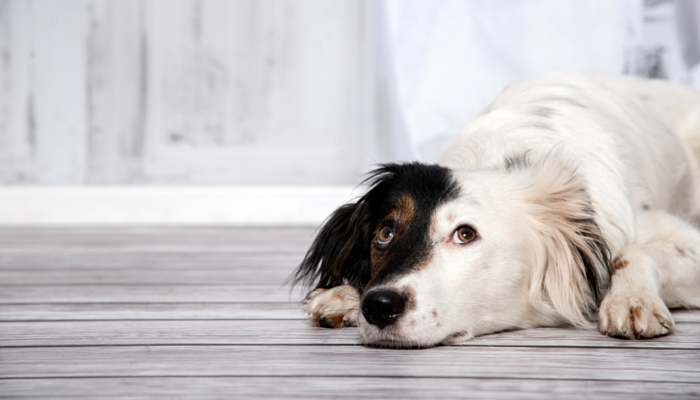
For many dogs with separation anxiety the act of us getting ready for work starts to cause stress and anxiety. You can help keep your dog calm by handing them treats as you practice getting ready.
2. Leave For Short Periods of Time
Once you’re able to keep your dog calm as you do your “getting ready” activities you can then move onto going towards the door and actually leaving. Like before the goal is to do this in baby steps — once your dog can handle you walking towards the door you can then start to walk through it.
Depending on the severity of your dog’s separation anxiety this may take days, weeks or months of practice. It is tedious, but this process will help change the associations your dog has built up about you leaving. You can help break that negative association by practicing leaving for shorter periods of time.
By leaving at various times your dog will see that you don’t just leave for 8+ hours when you have to go to work. When you make short trips out of the house your dog will start to see that you leaving isn’t such a big deal because you are indeed coming back.
How to Keep Your Dog Calm As You’re Leaving
To practice with your dog start by leaving for just a few minutes at a time. My favorite method for this exercise is to give my dog something else to focus on as I’m leaving — and a nice yummy treat or stuffed Kong works well. The goal is to avoid causing fear and anxiety in your dog as you walk towards the door and leave.
If your dog is too anxious when you’re even near the door you’ll have to take a step back and practice moving towards the door without your dog getting upset before actually leaving.
The point of leaving for short periods of time is to normalize the behavior and desensitize your dog to it. It’s important to take your time with these exercises — if you go to quick your dog may become anxious, setting back any progress you’ve made.
With practice you’ll be able to keep your dog calm while you walk towards the door and leave. As I mentioned earlier it may take days or weeks of practice depending on how serious your dog’s separation anxiety is.
3. Give Your Dog Something To Do When You Leave
A stuffed Kong can be a life saver when it comes to treating mild cases of canine separation anxiety. When you’re getting ready for work in the morning does your dog start to get anxious? If so hand them a Kong stuffed with treats that you’ve frozen overnight. I prefer using Kongs because they’re indestructible (for my dog at least) and dishwasher safe.
Stuffed Kongs work so well because they give your dog something to do while you’re leaving, taking the focus off of you. They’re mentally stimulating, and there’s something about having to work for that extra food that works wonders when it comes to holding a dog’s attention.
My current dog Laika started exhibiting some anxiety when I’d leave for work a few years back. I used the stuffed Kong method with her and I couldn’t believe how well it worked. After a couple of days she didn’t even bother following me around as I was getting ready anymore — she was waiting by the freezer for her Kong.
Not sure what to use for Kong stuffing? I prefer using a “base” of peanut butter or low sodium broth and mixing it with some veggies or homemade dog treats. To freeze a Kong fill it with your stuffing and place it into a large cup or bowl (small side down), and then place it in the freezer overnight. You don’t have to freeze your stuffed Kong, but it will make it last so much longer. If you’re looking for more Kong stuffing ideas here’s a list of 39 healthy treats to stuff in a Kong.
If your dog has a severe case of separation anxiety a stuffed Kong may not be enough to hold their attention; for severe cases I recommend seeking out the help of a professional trainer.
4. Teach Your Dog Independent Behaviors
Dogs with separation anxiety develop a hyper attachment to their owners. Some dogs have been bred to be more dependent than others, and sometimes we ourselves inadvertently encourage clingy behaviors. We’ll never know exactly why some dogs develop it and others don’t, but there are some ways to manage it.
One trick I used to help manage canine separation anxiety is to encourage them to do things on their own or at a distance from you. If your dog gets nervous when you’re out of sight you can start encouraging them to engage in some independent behaviors. By keeping it positive your dog will learn that they don’t always have to be right by your side in order to be content and comfortable.
Independent Behaviors To Encourage In Your Dog
Teaching your do to do things on their own, or at least at a distance, can boost your dog’s confidence when it comes to being away from you. To encourage a little more independence in your dog practice some of the following:
Playing games that rely on distance. Nose work games, hide and seek, and fetch are all fun games that reinforce having fun while you’re at a distance. Over time your dog will start to see that they don’t always have to be right by your side to have fun and be comfortable.
Give your dog their own special place. Make your dog’s bed, mat or crate a really special place for them. Reward your dog when they go there, and keep it fun and positive by giving him some special toys or treats when he uses it — something that will make him happy to be there.
Desensitize your dog to your movements. Dogs with separation anxiety have a tendency to react every time we get up because it means ‘uh oh, they’re going somewhere.’ Start practicing getting up without going anywhere so your dog will start to see that any little move you make isn’t such a big deal.
To desensitize your dog to your movements practice getting up and doing something mundane. Repeat this behavior until your dog doesn’t give a reaction anymore. Eventually she’ll become desensitized to your movements and will stay in place as you get up.
Giving your dog a puzzle/food toy to work on. One of my favorite ways to encourage independence in my dog (and add plenty of mental stimulation) is to use a treat dispensing toy for her meals. It gives her something productive to do that doesn’t require me to be right by her side. And as I mentioned before long lasting dog toys or a stuffed Kong toy are good at creating distractions while you’re up and about.
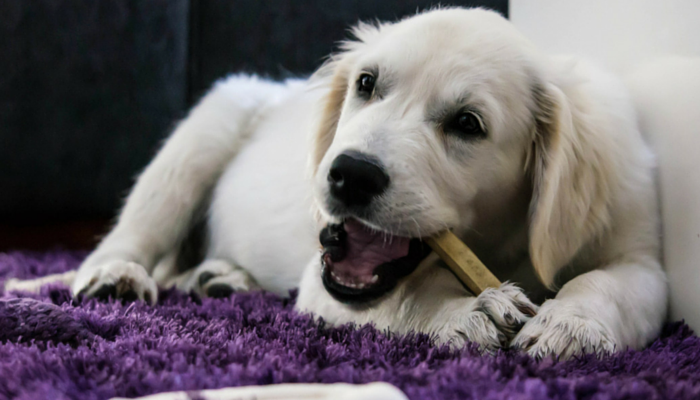
One way to help manage your dog’s separation anxiety is by encouraging independent behaviors. Give your dog something fun to do on their own such as a long lasting chew toy, puzzle toy or stuffed Kong.
5. Keep Your Dog Physically & Mentally Exercised
Giving your dog plenty of mental & physical exercise can help cut down on many problem behaviors, including managing canine separation anxiety. It may not be enough to cure separation anxiety on it’s own, but giving your dog plenty of mental & physical exercise will certainly help.
Most of us go to work in the morning, and for many dogs that means we leave without giving our dogs a chance to burn off any energy (this can be especially troublesome for young, energetic dogs). Before leaving for work in the morning take your dog for a quick walk or jog, or fit in a quick game of tug or fetch.
Now I know it’s hard to find the time to play or exercise your dog in the morning, but keep in mind it doesn’t have to be an hour long walk. Something as simple as a a 5 minute game of tug or 10 minute walk can make such a difference.
Want some quick ways to tire out your dog in the morning? Here are my favorite ways to quickly tire out your dog:
- Using a flirt pole
- Frisbee
- Game of tug of war
Mentally stimulating activities are a great way to keep your dog entertained and help burn off some extra energy. They also encourage your dog to work alone on some problem solving skills which can be a great help for dogs with anxiety. Some of my favorite ways to give my dog more mental stimulation include:
- Food & puzzle toys
- Game of find the treats
- Teaching new tricks
- Stuffed Kongs/puzzle toys
Once Your Dogs Separation Anxiety Seems Better
Once your dog’s separation anxiety is manageable it’s important to keep an eye on their behavior and make sure things stay good. Sometimes our dogs can start showing anxious behaviors again, even after proper management.
Now I’m not saying that your dog is going to revert back into full panic mode when you leave — that’s probably not going to happen. But what can happen is that your dog’s anxious behaviors may start slowly creeping up again if you don’t practice keeping your dog calm from time to time. You don’t have to do it every day, but a couple times a month can make a big difference.
If Your Dog Has Severe Separation Anxiety
Severe cases of canine separation anxiety are hard to manage. These tips will work for dogs with mild to moderate cases of separation anxiety, but when it comes to severe cases I recommend seeking out the help of a professional trainer or behaviorist.
It’s no fun being in panic mode all the time, so it’s imperative that you reach out for help if you’re unable to get your dog’s anxiety under control on your own.
Rehabilitating a dog suffering from severe SA may require months of painfully incremental steps of desensitizing the dog to his fear of being left alone and/or confinement. – Helping a Dog With Severe Separation Anxiety
Resources For Managing Canine Separation Anxiety
- Don’t Leave Me! A Step by Step Help For Separation Anxiety by Nicole Wilde – Amazon (affiliate link)
- Separation Anxiety – ASPCA
- Sealing With Separation Anxiety in Dogs – MSPCA
- Managing Your Dog’s Separation Anxiety – Karen Pryor
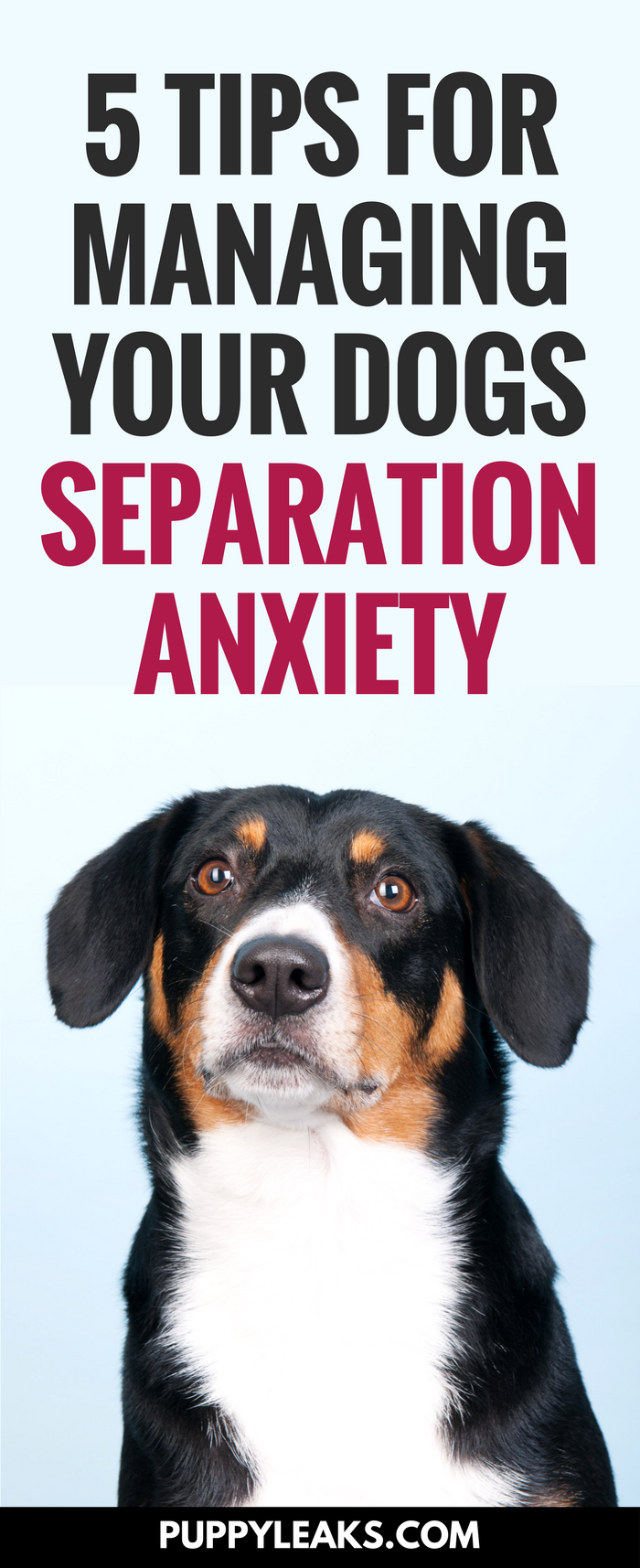
Please share with your friends
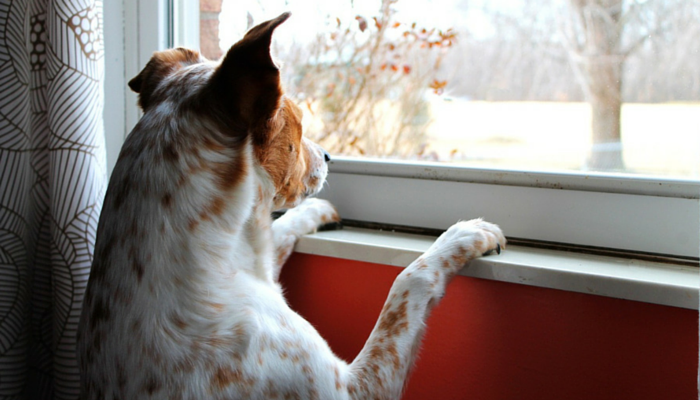
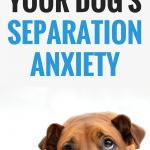
My wife’s dog used to have pretty bad separation anxiety, but when I moved in I brought my dog with me, and that seemed to help her little guy some. I also bought him a new cage, which helped as well.
Of course, there’s no promise that since this worked for us, it will work for anyone else.
He still has some separation anxiety – but it’s manageable. He likes to bark at my wife when we come home – what I refer to as him “giving her a talking to” about leaving him.
Very heartbreaking. I can’t afford to see my dog suffering from this anxiety that’s why everytime I go to work, I always put a tracker on his collar even if he is with my mom so that I can track where he is. I’m using trackimo, a real- time gps tracking device.
This problem can be very difficult for us dog lovers but this blog will teach us on how to manage or how we can handle this separation anxiety Thank you for this information.
I use calming AIDS and a calming collar. I use essential oils in diffusers. These work very good with separation anxiety. Leaving a pillow case or shirt you have slept in with your smell works well too. I recently purchased a calming aid with CBD oil in it, works very good.
This is great! My friend’s dog shows some signs of separation anxiety. Now I can help her manage it!
My dog is NOT food motivated at all. I’ve used a thundershirt and he chewed it off, twice. Not sure what my options could be. Suggestions?
It can work either way, our daughter tried it on her dog and her anxiety got worse.
A few weeks back I bring a new Bernese mountain at home and on daily basis, I keep spending some time on his training and my friend remain confined in this time and nearly after six weeks he starts behaving differently, in the end, the vet….. told me he is suffering from separation anxiety. The reason that I find is both of pups used to live in separate places and to get a solution I combined them in bigger space and now they are a friend and anxiety symptoms are nearly over.
Hi Jen!
So important! The behavior associated with separation anxiety is one of the top reasons dogs are surrendered. When we adopted our first dog he would sit on our shoes as we tried to get ready to leave the house. The first time we crated him, he ate a blanket.
Separation anxiety is a physical and mental reaction to the fear of abandonment. It manifests in many different ways, but the core issue is the insecurity of animals about being deserted. I used to have a dog with separation anxiety as well. But what did help is that we had a cat as well, and just that extra animal around was some form of company for him. Also, I feel spending a short time away and then reward your dog after coming back helps a lot.